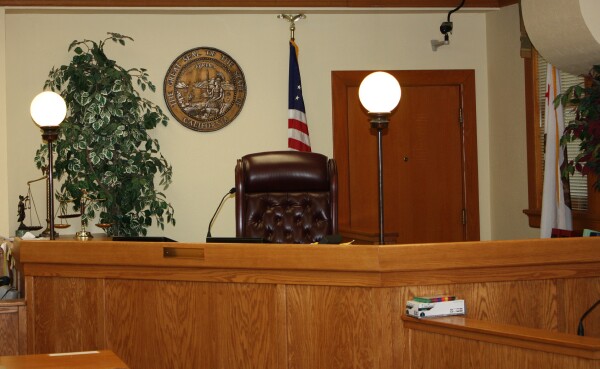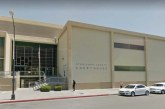 A Yolo County Jury found Steve Sargent not guilty of gross vehicular manslaughter for his role in a fatal accident that killed his passenger. The jury would deadlock on a lesser included charge of vehicular manslaughter, 8-4 in favor of acquittal, and 7-5 also for acquittal on a charge of failure to stop.
A Yolo County Jury found Steve Sargent not guilty of gross vehicular manslaughter for his role in a fatal accident that killed his passenger. The jury would deadlock on a lesser included charge of vehicular manslaughter, 8-4 in favor of acquittal, and 7-5 also for acquittal on a charge of failure to stop.
On November 9, 2007, Steven Sargent was driving to Cache Creek Casino on County Road 19. He was going at a high rate of speed, and was slow to react to a flashing warning light for a stop sign, where the road basically dead ends into County Road 87.
Realizing the peril too late, Mr. Sargent slammed on his brakes and skidded through the stop sign, across the road where his vehicle landed in a ditch.
Mr. Sargent’s friend Larry Bruce died at the scene. A tragic accident? Not in Yolo County. Mr. Sargent faced the charge of gross vehicular homicide.
To build his case, Deputy District Attorney Chris Bulkeley would argue that Mr. Sargent, while not intending to cause harm, was reckless in his actions on the night in question and took risks that a reasonable person would know to be risky actions, and that the conduct was sufficiently different from how an ordinary careful person would act.
Mr. Sargent was speeding at night on a dark road with which he was unfamiliar. He acknowledged to the highway patrol officer that he was driving roughly 70 mph in a 55 zone. He admitted to have consumed a 22-ounce beer and one shot of peppermint schnapps earlier that evening.
Mr. Sargent was tested at the scene and a breathalyzer test was performed. He had a blood alcohol level of .04 which was below the legal limit.
In order to bolster the case that an ordinary person would know that driving with any alcohol in one’s system presented a risk, Mr. Bulekley brought blood-alcohol expert Joseph Palecek to testify that any level of alcohol consumed presented a danger.
Mr. Palecek had been brought into the Topete trial to testify about Mr. Topete’s abilities to take his vehicle on a high speed chase, and he used similar tests to suggest that Mr. Sargent was impaired at a blood alcohol level far lower than the legal limit.
Mr. Bulkeley went to great lengths to show the jury where the flashing sign was, and to demonstrate it was in existence and working at the time of the accident.
He argued that it was impossible to miss the lights, and that he either reacted slowly due to alcohol consumption or he chose to ignore the warning lights, which were approximately 610 feet from the stop sign.
Skids marks show he did not brake until he was roughly 115 feet from the stop sign, and at that point and at that speed it was too late to stop.
But while the DA made a compelling case that Mr. Sargent clearly had made serious errors in judgment, there were a number of factors that mitigated against a finding of gross vehicular manslaughter.
As Public Defender Emily Fisher acknowledged, ordinary and reasonable people speed each day. In fact, the jury did find Mr. Sargent guilty of speeding – an infraction, the only charge they concluded him guilty of.
She argued that there was no evidence that he intentionally ignored the warning lights, that there was no warning on the sign that this was a curve that was essentially a T-intersection that would have required a 90-degree turn. Beyond it was a ditch and there was no guard rail.
She argued that this was not gross negligence but rather mistakes in judgment. It was a perfect storm of mistakes and conditions that led to this tragedy.
In fact, one of the big problems that likely weighed on the minds of jurors is the fact that Mr. Bruce was not wearing his seatbelt. And while Mr. Sargent was not legally drunk, Mr. Bruce had a blood alcohol level that was .22 and he had tested positive for narcotics in his system as well.
All of this suggested that Mr. Bruce himself greatly contributed to his own demise by failing to wear a seat belt. The coroner testified that had he been wearing a seatbelt, Mr. Bruce would likely still be alive.
The cause of death was a puncture wound to his lung. Yolo County Chief Deputy Coroner Robert LaBrash testified that the airbags were insufficient by themselves to prevent serious injury and needed to be utilized in conjunction with a seat belt, which was not worn.
While Mr. Bulkeley countered that this too was in the purview of the defendant, it seems likely that the jury may have seen it differently.
Ms. Fisher argued that CHP Officer Schwab made his own mistakes in that he believed that Mr. Sargent was using opiates at the time of the accident, but later tests confirmed he had not. Officer Schwab was the only one who would observe Mr. Sargent that evening.
The DA tried to argue that the distance of 500 feet, between the flashing light and where Mr. Sargent’s skid began, was great and one should recognize that it take less than five seconds to travel 500 feet at 70 mph. However, while the authorities could pinpoint the beginning of the skid, they have no way of knowing where the brakes were actually first applied.
In his defense, Ms. Fisher argued that his only real mistake that night was speeding. She suggested that it was a dangerous intersection, that it was under construction and that there was loose gravel, not only from the construction but from gravel delivery trucks that frequent this route.
Moreover, the jury likely saw that, while 70 mph was speeding, it was not a ridiculous rate of speed. In fact, people on other roads travel at that speed all of the time – sometimes even legally.
It is not as though he were driving 90 mph with a blood alcohol level far exceeding the legal limit.
It seems a stretch to argue that because, scientifically speaking, they can show that drinking any alcohol increases the risk of misjudgments, that drinking a legal quantity of alcohol would represent gross negligence to the point where it could be construed as something so opposite to what an ordinary person would do.
In the end, this case was a tragic accident that cost one person his life and likely ruined another man’s life, in one way or another. However, what it was not was manslaughter or a felony crime.
—David M. Greenwald reporting





I wonder if fatigue had anything to do with this accident??? My daughter had a college friend, who died in just this way. The friend and two other girls squeezed a trip to LA from Davis into three days, making a late start back on Memorial Day Monday. Just as they arrived back in Davis at 1 am, the driver attempted to make a lane change to get off onto the Davis exit, and didn’t see a car to her left side. She swerved, lost control of the car, and crashed. My daughter’s friend had been a passenger in the back seat and the only one not wearing a seat belt. She normally was religious about using a seat belt, but the long car trip had caused her to take the seat belt off and lie down in the back of the car. When the car crashed, my daughter’s friend was ejected through the front windshield and died instantly. Her two friends both had their seat belts on, and survived. Fatigue had clearly been the cause of the accident.
I think what made me so angry is that the girls who went on that trip never seemed to recognize they very much contributed to my daughter’s friend’s death. The girls who survived attributed their friend’s death to the failure to wear a seat belt. But they did not take any responsibility for making the poor decision to make such a long trip in such a brief time, on just about the most traffic crowded day of the year, so late at night.
In consequence, I approached the UCD Police Dept, noting to Chief Spicuzza that three UCD students died that same weekend, all bc of driving while fatigued (another death had been early in the morning after studying for an exam all night). I asked Chief Spicuzza to warn students about the dangers of driving while fatigued. IT IS NOW INCLUDED AS PART OF THE UC ORIENTATION OF FRESHMAN STUDENTS ON ALL CAMPUSES.
My daughter could have been in that car…
Elaine
I applaud your taking on the issue and addressing it in this way. Fatigue and distraction are just starting to receive the attention they deserve
As causes of accidents. I personally would like to see a much higher level of warning about these dangers and if necessary, tighter restrictions and penalties for all non driving activities occurring while driving.
I have definitely been guilty in the past of drinking, snacking, fiddling with the radio and the like while driving, to say nothing of driving while fatigued which is practically part of the job description for an Ob/Gyn.. It is clear to me from my own lack of attention during these periods, that behind the wheel is no place to test one’s ability to multitask. Although the girls involved may not have been willing or able to discuss the portion of the responsibility attributable to their poor decision making, they will be living with its consequences for the rest of their lives. I am eternally grateful the my youthful misperception of my own invulnerability did not lead me into such a consequence
To medwoman: Thanks for your thoughtful response. You are correct, that these girls will live with the consequences for the rest of their lives. But the bigger question is did they learn from their mistake? That is where I have the big problem w their attitude the fault was all that of my daughter’s friend for not wearing a seat belt. If they don’t face the reality that they were very much responsible for this girl’s death bc of their poor decisionmaking of driving while fatigued, they are doomed to make the same mistake again. I don’t want tragedy to befall them or anyone else bc they repeat their negligence.
And you are so right about multi-tasking. Don’t do it while driving – it is DANGEROUS!
Just as an aside, these three girls borrowed a baking dish from us the day they left on this ill-fated trip. Three beautiful girls, all excellent students, young and fearless, drove off without a care. The baking dish was returned to us, but my daughter’s friend never made it back… it still haunts us to this day…
I also lost a young nephew to drunk driving – he was drinking and driving and wrapped his car around a tree. A needless death…
I would actually be surprised if Sargents responsibility to ensure all occupants are properly seat belted wasn’t brought up in this case.
27315(d)(1) VC says, [quote]A person shall not operate a motor vehicle on a highway unless that person and all passengers 16 years of age or over are properly restrained by a safety belt. [/quote]
It was mentioned by the prosecutor in his rebuttal, though he did not cite the vehicle code which was probably a rather substantial error on his part.
To Mr. Obvious: Interesting point…
Finding useful stuff about cars on the web is very difficult, this is because most of the times you just see marketing and promotional stuff and you are not able to get any information but this post will be really helpful I am sure.
Finding useful stuff about cars on the web is very difficult, this is because most of the times you just see marketing and promotional stuff and you are not able to get any information but this post will be really helpful I am sure.Toyota Prado | Hyundai Porter